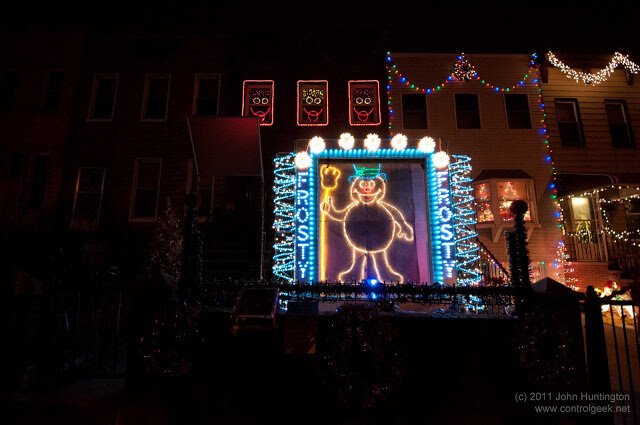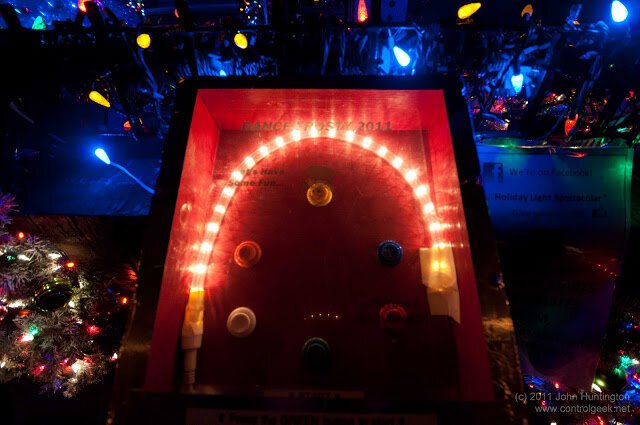Brooklyn's Holiday Light Spectacular
Over the years, I've covered a lot of holiday light displays like the Time Warner Center, the Wannamaker/Macys show in Philadelphia, and many others I have listed here. Yesterday, I checked out a show closer to home: my friend Ryan Powers and his friend Chris Schneider's Holiday Light Spectacular only a few blocks from me here in Brooklyn. It's definitely a home-brew, low-budget affair, but what they lack in funding they make up with theatrical know how, a story, and the polish so often lacking in other shows. This year the show is Frosty themed, and runs every 20 minutes:
The show features video projection, an automated curtain, and a smoke machine, and one thing that Ryan and Chris do that sets them apart is allowing interactive control of parts of the display between shows. Click any to enlarge
I emailed Ryan and asked him for some detail on the system, and he wrote so much detail I'll just post it all here, along with a few links [and editorial clarifications]:
For our display every year, we push the limits of the [very popular] Light-o-Rama software and hardware. The new S3 software released this year helps a lot, because they've added native support for DMX, which allowed us to use the RGB color mixing spotlights and floodlights, along with control the fog. (DMX controlled fog machines are EXPENSIVE! Who knew!)
We build the entire thing from scratch every year and start the day after Thanksgiving. We try to use as much recycled goods as possible (From the Film Biz Recycling place) Because we don't have anywhere to store any of it, most of it becomes trash when it's all over. I suppose that keeps our minds fresh for the next year. There's very little opportunity to "re-use". If you know anybody that wants to donate us some storage, that would be BRILLIANT. Even if it was just to store the lights and controllers at the end of the year. Since the display gets bigger and more complicated each year, that means more STUFF..
We try every year to "tell a story" rather than just do what we consider "Flash and trash". Anybody can make lights turn on and off to music. We try to make it something with a little more "beginning, middle and end". I'm glad to hear that translated.
So - here's the technical details:
- Four Light-o-Rama 16 channel lighting controllers giving us a whopping 64 lighting channels. (Every year we add a controller.. and it's never enough) We've modified a few of the controllers and put "dummy loads" on some of the channels in order to get smoother fades with the LED lights. LED's HATE to dim.
- Two "Rainbow Floodlights" and One "Rainbow Spotlight". These are color mixing RGB lights. They're controlled with what they call a "Rainbow Brain", which is basically a DMX controller that adjusts and mixes the 12v signals for each LED color. Paper Mill Playhouse hired us to build them a holiday light display this year, and we used a TON of these there. They're a lot of fun to use and not too terrible to program. You can see the Paper Mill display here.
- Enttec DMX Pro adaptor, which is essentially a USB to DMX adaptor. Allows us to talk DMX out of the control computer. We have two “languages” running through the display. Both the LOR Protocol (Light-o-Rama) and DMX.LOR is doing the lighting, DMX is doing the RGB color mixing and the fog
- One Light-o-Rama “ServoDog”, which is pretty much a DIO interface. It can either control servos, or can be configured to be a straight IN/OUT logic control type box. We’re using this to control the motor and to deal with the interactive button box.
- The curtain motor is a 12v windshield wiper motor. Those suckers have some serious torque and can really take a beating. It’s connected to a H-Bridge motor controller that I built from some little kit I found online. It basically takes three outputs from the ServoDog. One for “Enable” which basically turns the board on and off, then two for control of the motor in both directions. We had a huge problem with the motor when we first built the display in that depending on the weather (humidity and temperature) the motor would take different amounts of time to pull the curtain to the top. So it was never consistent. Some shows we’d go out there and the curtain was half covering up Frosty’s face because it didn’t go up high enough within the time we told the motor to run. (Remember, we have no other control other than ON/OFF over a specified amount of time. LOR doesn’t allow for any kind of logic.. It says “ON for 10 seconds” or whatever. It’s such a limiting piece of software.) So I bought a reflective beam sensor online – and mounted it to the top of the “proscenium” at the point where we wanted the curtain to stop. This essentially breaks the connection between the ServoDog and the Motor Controller once the curtain makes it to the appropriate height. So – we tell the software to run for much longer than it would ever take, and the sensor is doing the work with telling the motor controller to stop. I JUST installed that the day you saw the show. It’s been perfect ever since. (Had to use a pull-down resistor to force the motor controller to “LOW” for when the sensor breaks the circuit and leaves it floating, but other than that – it was an easy fix..)
- The button box is a bunch of arcade buttons acting as contact closures. There are 6 trigger inputs on the ServoDog board, which LOR allows you to associate with a particular sequence. They designed it to be used so that you can create a virtual jukebox, allowing you to have people select what song they want to watch. Obviously, I found a different use for it. ;) I made one sequence that lights up his body and plays the music (that is what the green start button does) , then I built tiny little one second sequences for each body part. (i.e. mouth open/close, arm up/down, etc.) each triggered by their own button. It works pretty well, except there’s the problem where if you don’t hit the green button first – you get just his body parts moving without a body. It’s a little creepy, actually. Again – you don’t get any kind of “if-then” logic. I need it to IGNORE the other buttons until the first button is pushed. I probably could have done it with relays inside the box, but I just ran out of time.
Hmmmm.. What else.. The fog machine is mounted inside the house so the fog fluid doesn’t freeze outside. Then we pump it out of the house and to the stage through PVC pipe. We burnt up two fog machines before we figured out how to do this right. It seems you can’t connect the tubing directly to the PVC pipe. There needs to be a gap for oxygen to mix with the fog before entering the pipe, otherwise the hot gases go right back in to the machine and fry it up. Again – WHO KNEW?! Then once we did that, there was a lot of fog coming back in to the house because it wasn’t a “closed” system. So – I bought one of those stupid blow-up yard Christmas decorations at Lowes and gutted it for it’s fan. I mounted the fan in to the stage end of the PVC pipe, thus creating a constant suction through the pipe. Now any of the fog that was escaping back in to the house is actively sucked through the pipe to the outside. We had to run the fogger at 50% (the beauty of a DMX controlled fogger) so it didn’t exceed the capacity of the fan’s suction. It’s not perfect and could still use some adjusting, but for the most part – it works.
The show computer is just some cheapo Compaq desktop with two monitor outputs. One for the monitor and the other for the projector. I edited and built all the audio first and made it line up in ProTools with the video, then mixed it all together with the video using Vegas Movie Studio. (Which is an amazing CHEAP and powerful video editing software program)
The biggest pain in the ass about the entire thing is fighting the elements. Making everything work in the rain, snow, sleet, wind and below-freezing temperatures. That really forces us in some unusual directions. (Like last year’s animatronic narrator.. We were constantly fighting the cold, and his parts freezing, but when it worked it looked SO COOL!)
More photos here, including a few "making of" shots that Ryan sent me.





